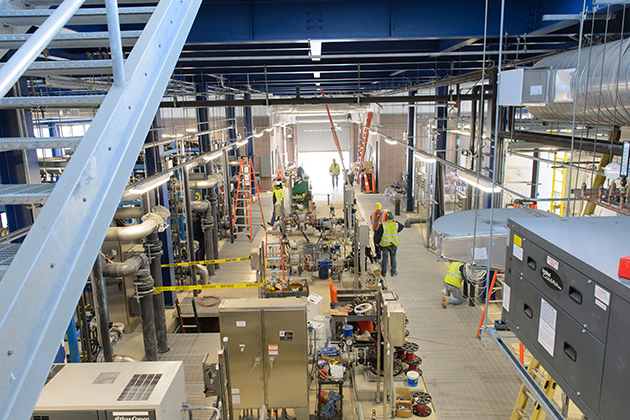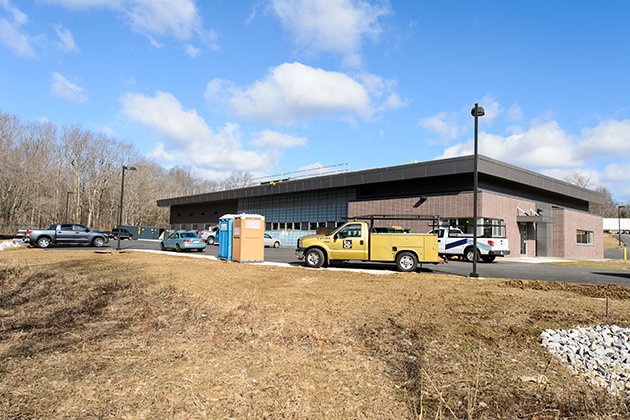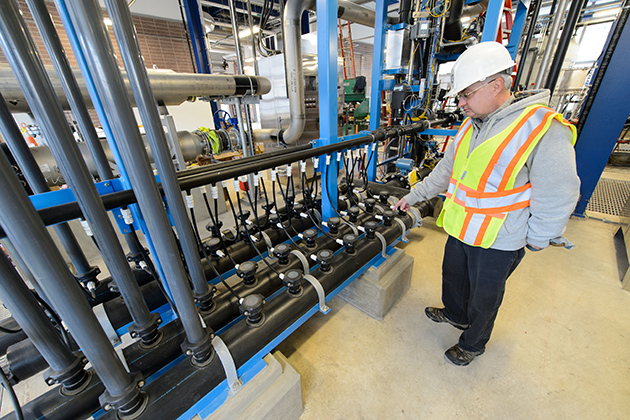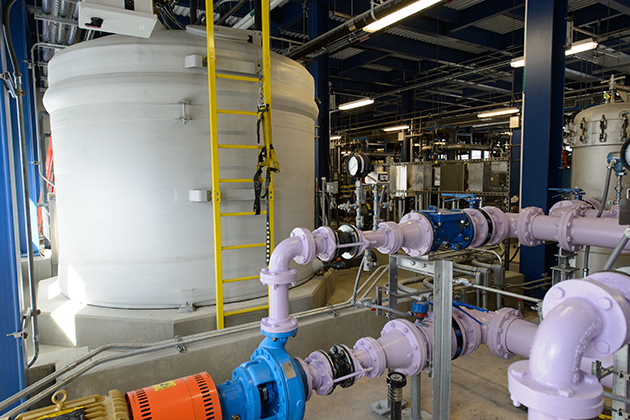
The University is on the verge of opening a new high-tech facility that will further enhance its water conservation efforts by saving hundreds of thousands of gallons of drinking-quality water every day.
The University’s Reclaimed Water Facility is coming online in stages over the next several weeks. If all remains on schedule, the reclamation facility will be fully operational by early summer – just as UConn’s power plant, which needs water to operate, starts facing heavy demand based on rising seasonal temperatures.

The facility, adjacent to the University’s Water Pollution Control Facility on LeDoyt Road, has been a hub of activity as crews finish work on the $25 million project. Initial planning for the reclamation project started in 2006 and construction began in 2011.
The facility will process about 230,000 gallons of treated wastewater on an average day and up to 500,000 on peak days, though it is capable of processing up to 1 million gallons.
The wastewater will be cleaned through an advanced process of microfiltration, reverse osmosis, and ultraviolet disinfection. The reclaimed water will then be used in place of drinking-quality water – also known as potable water – that is currently used to cool the turbines in the UConn cogeneration power plant. That plant provides electricity, air conditioning, and heat across most of the Storrs campus.

Switching the cogeneration plant’s water supply to the treated, non-drinkable water will save immense amounts of potable water, particularly on the most sweltering summer days, and better help the University manage and conserve drinking-quality water.
The facility, which is the first water re-use project of its kind in Connecticut, has already been winning awards, and some UConn faculty members plan to incorporate lessons about its technology into their class work.
“The facility is an excellent example of how innovations on UConn’s campus can provide a living laboratory for educating our students about green technologies and environmentally sustainable operations and practices,” says Richard Miller, director of UConn’s Office of Environmental Policy. “It’s another way in which the University translates its policies into the hands-on practice of water conservation and sustainable development.”
In the future, the reclaimed water from the facility may also be used for irrigation purposes – for use on athletic and recreational fields, for example.

Several sustainable design features were incorporated into the reclamation facility itself, including features to capture stormwater runoff from the roof, recover heat from exhaust air, and generate power from photovoltaic cells.
With the only public water supply system within a 5-mile radius, the University is responsible for providing water not only to meet the needs of the Storrs campus, but also for more than 100 users across parts of Mansfield, including the Town Hall, E.O. Smith High School, and the emerging downtown Storrs Center.
Reclaiming hundreds of thousands of gallons of water at the new facility will also help make UConn’s system more versatile.
Prioritizing the use of potable water for domestic uses, while targeting reclaimed water to cooling and irrigation-related uses, “will be particularly important to managing demand for potable water when overall demand is at its highest – typically from September to October, when students return to campus for the start of the academic year,” says Thomas Callahan, associate vice president.
UConn’s water is drawn from groundwater wells near the Fenton and Willimantic rivers, consistent with state permits that regulate how much water can be withdrawn.
The plan is part of a larger series of conservation efforts, under which the campus currently uses less water now than it did a decade ago, despite having a larger population and more buildings to serve.
Conservation efforts include ‘green’ building design practices, the widespread use of drought-tolerant plants in areas that collect runoff and roof drainage, the addition of low-flow fixtures in campus buildings, eliminating trays in dining halls to avoid the need to wash them, outreach efforts to and by students to spread the conservation ethos, and other measures.



